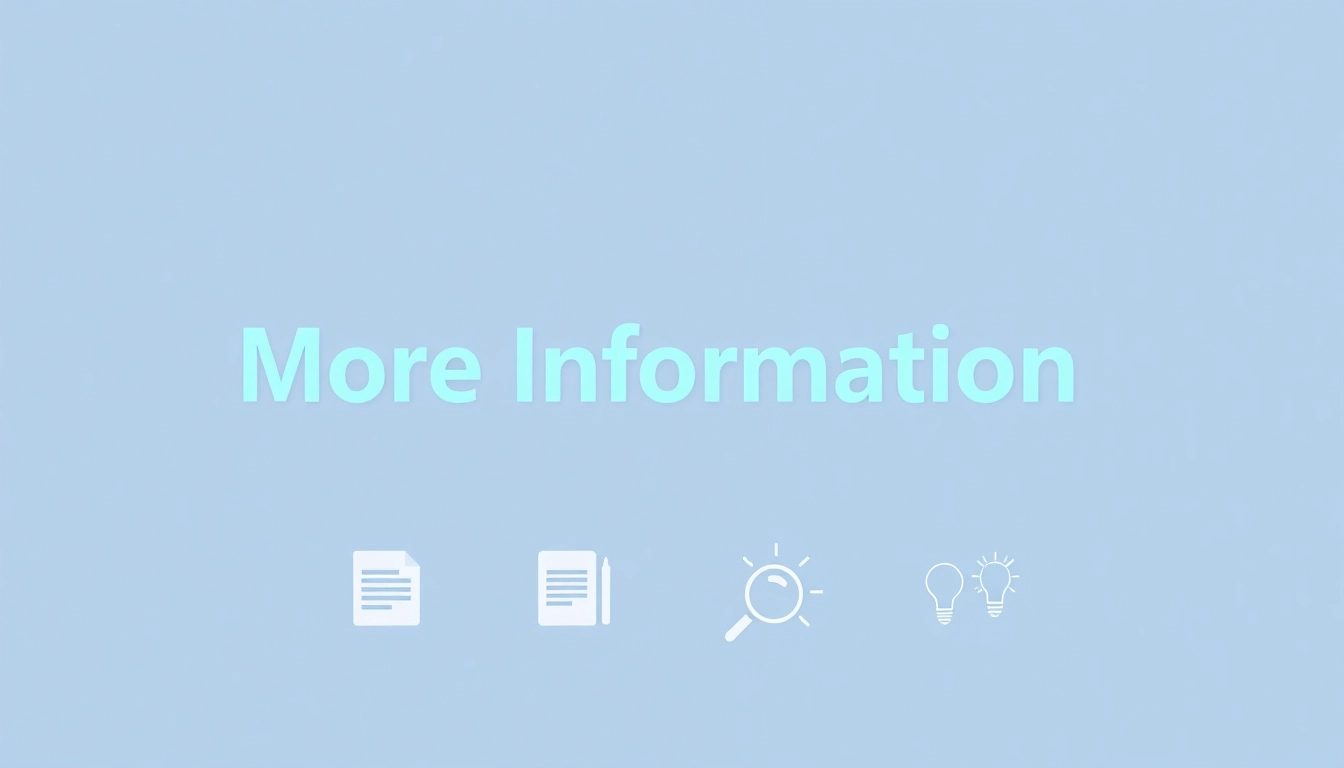Understanding How to Convey More Information Effectively in Your Communication

What is More Information?
The Definition of Information
Information is a broad and complex concept that refers to data or knowledge communicated or received concerning a particular fact or circumstance. It is crucial that information is relevant and accurate, as it forms the narrative around which decisions, discussions, and understanding are built. The term “information” can encompass anything from numerical data to qualitative observations.
More specifically, information entails the organization and structuring of data in a way that is digestible and applicable. It should not simply be a collection of facts but rather insights that can guide actions or decisions. Whether it be in educational contexts, business environments, or everyday situations, the clarity and utility of information contribute significantly to its definition and value.
Why More Information Matters
In a world where we are constantly inundated with data, the demand for more information has never been higher. Providing more information is not merely about overwhelming an audience with facts; it is about enhancing understanding and facilitating better decision-making. In businesses, clear and comprehensive information can influence strategic planning and operational effectiveness. In educational settings, more information deepens comprehension and fosters critical thinking.
Moreover, more information leads to improved transparency and trust. When organizations share information openly, they build credibility and rapport with their clients and stakeholders. This is particularly relevant in fields such as public health, finance, and environmental studies, where informed decisions can have far-reaching consequences.More Information is essential for effective communication and fostering strong relationships.
Common Uses of the Term
The term “more information” is frequently used in several contexts, ranging from formal documents and presentations to casual conversations. Here are a few common scenarios:
- In Marketing: Companies often urge potential customers to seek more information about their products or services, using phrases such as “For more information, visit our website.”
- In Education: Educators frequently invite students to explore more information on a topic, encouraging external research and discovery.
- In Customer Service: Customer representatives often provide more information about policies, products, or services to clarify inquiries posed by customers.
Ways to Structure More Information
Creating Comprehensive Outlines
Creating a comprehensive outline is essential for structuring information effectively. A well-developed outline serves as a framework that guides the presentation of information, ensuring that all key points are covered and logically arranged. This organization aids in both understanding and retention for the audience.
Here are steps to create a comprehensive outline:
- Identify Key Topics: Determine the main themes or topics that need to be addressed.
- Break Down Subtopics: Divide each main topic into subtopics to cover specifics in further detail.
- Prioritize Content: Organize the subtopics in a logical sequence that enhances flow.
- Use Bullet Points: Implement bullet points for clarity, especially when outlining facts or examples.
Using Visual Aids for Clarity
Visual aids often enhance the absorption of complex information. Studies have shown that people retain information better when it is presented visually. Graphs, charts, infographics, and PowerPoint presentations can transform dense information into engaging and comprehensible formats.
Consider including the following types of visual aids:
- Graphs and Charts: Useful for displaying numerical data at a glance.
- Infographics: Combine visuals with text to present information in a visually appealing manner.
- Diagrams: Effective for explaining processes or hierarchies in complex topics.
Organizing Information Logically
The organization of information is essential for effective communication. A logical flow of information helps the audience understand and engage with the material being presented. Here are several strategies:
- Chronological Order: Present data or events in the sequence they occurred to help the audience follow along.
- Prioritize Information: Begin with essential facts before delving into more detailed aspects.
- Thematic Organization: Group related topics together to strengthen the connections between them.
Best Practices for Providing More Information
Keeping Content Relevant
In today’s fast-paced world, attention spans are shorter than ever. Thus, presenting relevant information is vital. Ensure that every point made relates directly to the main topic at hand.
This can be achieved by:
- Staying Focused on the Audience’s Needs: Understanding your audience’s interests and informational needs is crucial.
- Regularly Updating Content: Revisit and refresh the information to keep it applicable and relevant in changing contexts.
- Filtering Out Noise: Avoid including superfluous information that detracts from the main points.
Engaging Your Audience
Engagement is critical in ensuring that the information is not only received but also understood and retained. Here are several techniques to enhance audience engagement:
- Ask Questions: Incorporate questions throughout the presentation or document to invite interaction.
- Utilize Storytelling: Frame information in a narrative to make it relatable and memorable.
- Encourage Feedback: Create avenues for your audience to ask questions and express their views on the presented information.
Utilizing Effective Call-to-Actions
A well-placed call-to-action (CTA) encourages your audience to take specific steps based on the information provided. These actions can range from visiting a webpage to downloading a product guide or signing up for a newsletter.
To create effective CTAs, consider:
- Clarity: Make the action clear and straightforward.
- Urgency: Instill a sense of urgency to motivate immediate action.
- Value Proposition: Clearly communicate what benefit the audience will receive from taking the action.
More Information in Digital Formats
Optimizing Online Content
In the digital age, information is more frequently consumed online, making it crucial to optimize content for better visibility and engagement. Here are some strategies for optimizing online content:
- Keyword Research: Use keywords strategically to enhance discoverability on search engines.
- SEO Best Practices: Implement meta tags, alt text for images, and internal links to improve SEO.
- Mobile Optimization: Ensure that content is easily accessible and navigable on mobile devices.
Effective Use of FAQs
Frequently Asked Questions (FAQs) sections can be invaluable in providing more information efficiently. They allow you to anticipate and answer common queries that your audience may have.
To maximize the effectiveness of FAQs:
- Organize by Topic: Segregate questions into categories to help users find answers quickly.
- Keep Responses Concise: Provide clear, simple answers to maintain reader engagement.
- Regularly Update the Section: Revisit the FAQs periodically to add new questions based on user feedback.
Leveraging Social Media for More Information
Social media provides a dynamic platform for sharing more information and engaging with your audience. It can be used to disseminate content quickly and to interact in real-time.
Consider the following tactics for successful social media use:
- Create Shareable Content: Infographics, videos, and interactive posts tend to garner more engagement.
- Utilize Hashtags: Hashtags can help categorize posts and increase visibility.
- Engage with Followers: Respond to comments and queries to foster a community around your content.
Measuring Impact of More Information
Tracking Engagement Metrics
After providing information, it is essential to measure its impact. Engagement metrics provide insights into how well the audience received and interacted with the content.
Common engagement metrics include:
- Page Views: The number of times a page has been viewed, indicating interest.
- Time on Page: How long users stay on the page can suggest content effectiveness.
- Conversion Rates: The percentage of users who take the desired action (e.g., signing up for a newsletter).
Feedback and Iteration Methods
Gathering feedback allows you to understand the audience’s needs better and iteratively improve your offerings. Consider these feedback collection methods:
- Surveys and Polls: Directly asking the audience for their opinions can yield valuable insights.
- User Interviews: Conducting in-depth interviews may provide deeper understanding into user needs and experiences.
- Analytics Tools: Tools such as Google Analytics can offer data on user behavior and preferences.
Adjusting Perspectives Based on Data
To maximize the impact of the information provided, it’s crucial to remain adaptable and responsive to the insights garnered from data. This may involve:
- Regularly Revisiting Goals: Assess whether the objectives remain aligned with audience needs and behaviors.
- Continual Learning: Staying up to date with trends and shifts in audience preferences.
- Flexibility in Strategy: Adjusting strategies based on performance metrics enables a more targeted and effective approach to information dissemination.







